Freezer Aisle Finds for Baby-Led Weaning
- Cauliflower rice
- Hash brown potatoes
- Ezekiel bread
- Frozen fruit
- Edamame
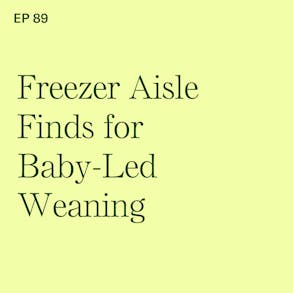
LISTEN TO THIS EPISODE
Episode Description
The freezer aisle at your grocery store has some fabulous foods you can feed your baby. Yes of course there are ultra-processed convenience foods there too that babies shouldn’t have, but don’t totally discount the freezer aisle!
In this episode I’m walking you through 5 of my favorite freezer aisle finds that work great for feeding babies. If you’re currently only “shopping the perimeter” at the store, you’re going to want to take a listen and see if any of these 5 foods you might serve your baby!
Links from this Episode
- Baby-Led Weaning with Katie Ferraro program with the 100 First Foods™ Daily Meal Plan, join here: https://babyledweaning.co/program
- Baby-Led Weaning for Beginners free online workshop with 100 First Foods™ list to all attendees, register here: https://babyledweaning.co/baby-led-weaning-for-beginners
Other Episodes Related to this Topic

Latest Episodes
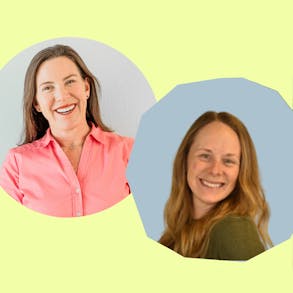
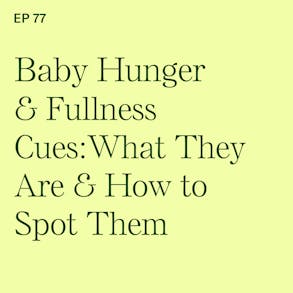
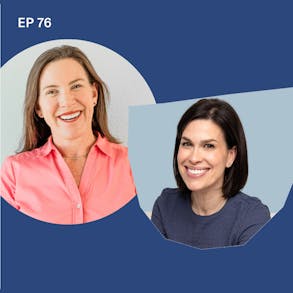
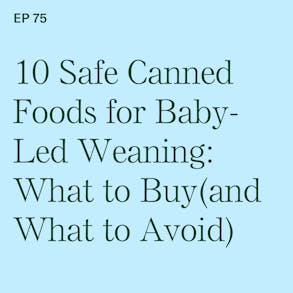

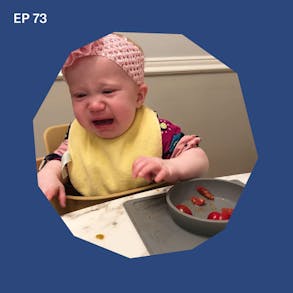
Katie Ferraro (0s):
So, yes, this idea of when you're at the grocery store, skip the middle aisles and only shop the perimeter. There's some validity there because yeah, the ultra processed foods are in the middle, but the freezer aisle, which is also in the middle of grocery store has a ton of great low sodium options for babies too. Hey, there I'm Katie Ferraro, registered dietitian, college nutrition professor and mom of seven specializing in baby led weaning. Here on the baby led weaning made easy podcast, I help you strip out all of the noise and nonsense about feeding, leading you with the confidence and knowledge. You need to give your baby a safe start to solid foods using baby led weaning He guys, welcome back.
Katie Ferraro (43s):
Today we're talking about frozen foods for baby led weaning, and I don't mean the types of foods that you like cook and put in the freezer and use again in the future. Like this is where you're at the grocery store in the frozen food aisle. And you're curious, what kind of foods can you choose to feed your baby? Now, I don't want to discount making food and freezing it because that's an awesome technique as well. I just did a podcast number 86. It was with the two time food network, chopped champ, chef Tatiana Rosana. She was here talking all about baby led weaning meal. Prep go back to episode 86. If that's what you're looking for. This episode, we're talking about what foods you can feed your baby that you pick up in the frozen food aisle. So I like to start each of these mini baby led weaning training episodes with a baby led weaning tip of the day.
Katie Ferraro (1m 28s):
And when it comes to frozen foods, my tip is you guys can learn to be a sodium sleuth. That's because the frozen food aisle is packed with a lot of good, but also many more, not so great food choices for babies and the not so good ones are not so good because a lot of frozen foods tend to be convenience foods or processed foods that are full of salt and therefore not appropriate for babies to eat. So just keep an eye on the sodium levels because there's lots of great fines in the frozen food aisle. You just have to look at the labels. And just as an aside, when it comes to sodium, my general rule of thumb for baby led weaning is that I look for foods that have less than a hundred milligrams of sodium per serving if I'm going to offer to my baby.
Katie Ferraro (2m 12s):
So for more information about limiting sodium for your baby, go check out episode number 33, it's all about salt. It's called salt three easy ways to minimize sodium for your baby. For more information about limiting sodium for your baby, go check out a previous episode that I did. It was episode 33. It's all about salt, three easy ways to minimize sodium for your baby. If you're like, wait a minute. Why she talking so much about salt? If you listen to the podcast regularly, you'd be oh yeah, she's always talking about salt. And you might have ruled out the frozen foods aisle. So this episode is going to make you fall back in love with frozen foods for baby led weaning, but hang tight because I'm going to be sharing my actual five favorite freezer aisle fines in this episode. So let's go ahead and dive in and learn a little bit about freezer, aisle fines for baby led weaning.
Katie Ferraro (2m 57s):
So quick story before I get started, whenever I talk about frozen foods, someone inevitably will say, I've heard at the grocery store, you're supposed to skip the middle aisles and shop the perimeter. Now this is in some ways a good recommendation. This is generally attributed to Michael Pollan in his book, food rules and eaters manual, Michael Pollan, well-known food journalist and author. He wrote stay out of the middle of the supermarket, shop the perimeter of the store. Now there are lots of great foods throughout the store, and I agree with Michael Paul and like most of the process in packaged junk is living in the middle aisles. But I kind of just take a little bit of issue with that because the canned food aisle is a great option for babies.
Katie Ferraro (3m 37s):
In episode 75, it went all through canned foods that can work for baby led weaning, and also there's foods like lentils and dried peas and beans and the whole freezer aisle, where there are some good finds. So when I was after graduate school, I taught nutrition at UC Berkeley. I taught full-time in their dietetics program and I was like the youngest faculty member. So I got the crappiest teaching assignments. And then I also got the crappiest classroom, but I always would volunteer to teach summer because everyone else didn't want to and I wanted to make extra money. And I remember getting stuck with my nutrition class in. At Berkeley, we normally were in the nutrition classes for, in the nutrition building and the school of public health building. But this one particular summer class, for whatever reason, I got stuck in the journalism building.
Katie Ferraro (4m 18s):
And I remember it was the same summer that Aaron Rogers was in my class. It was my claim to fame as a nutrition teachers, Aaron Rogers is in my class and everyone always asks what his grade was. And I think it would be a violation of some sort if I told you, but I don't remember what it was regardless. I didn't even know who Aaron Rogers was at the time. Michael Pollan was much more on my radar as far as like celebrities go. And he was teaching in the journalism school at UC Berkeley at that time. And I remember he came into my class one day and just sat in the back row and taught, like, watch me teach nutrition. And it was a smaller class cause it was summer, but we were talking about processed and packaged food. So I saw him, of course I knew who he was very striking presence, like looms, very large in the world of journalism at UC Berkeley. And I remember just bringing up the issue of the conundrum of the shopping, the perimeter, like someone very famous once said referencing him and then talking about, you know, what potentially helpful foods you could find in the middle aisle.
Katie Ferraro (5m 9s):
Kind of like quizzing my students. And a few of them were mentioning foods that you could find in the middle aisle. So he kind of was snickering and laughing. He said, no, no, you're right. There are some good foods you can find in the middle of the supermarket. He just kind of stopped in to see like, what were they teaching about in the summer in his building, very nerve wracking as a professor to have Michael Pollan walk in on your class. But it was kind of cool that we could have him talk a little bit about that. Cause I know shopping the perimeter is a good idea, but there are good foods in the middle aisles. And even Michael Pollan would tell you that, but they're not all created equal. So let's look at the frozen foods that do work for baby led weaning. All right. So let's get right down to it. I don't need to tell you about all the foods that don't work in the frozen food aisle. Let's focus on all the foods that babies can eat, right?
Katie Ferraro (5m 50s):
Of course, frozen dinners and frozen pizzas and food with lots of salt and sugar babies should not have and there's a lot of those foods in the frozen food aisle. I'm going to go through five of my favorite foods for baby led weaning. This is not an exhaustive list. Every time I do this, I start with the list of like 30 things. And then I'm like, that'll be too long, narrow it down to five. Here's five of my favorite foods. I love cauliflower rice. I love regular cauliflower. There's a million different ways you can make cauliflower safe for babies to eat. I don't offer cauliflower rice is like a lower calorie, low carb option. Like the reason why a lot of adults cauliflower rice, I think it's a really cool way to impart a different flavor in different foods. And it's a convenience food. Normally it would not pretty frugal. I would not spend money on many produce convenience foods.
Katie Ferraro (6m 31s):
Like no thank you. I can cut up watermelon by myself. I don't need you to quintuple the price and do it for me. But cauliflower rice is one that is a pain in the neck to make and you can find it in the frozen food aisle. How do you use it for baby led weaning? I like to use cauliflower rice when I make fritters it's it's already all chopped up it's rice. Like it's a very, very fine dice, consistency or size, I guess more so than consistency. So you can use it in. If you're baking like zucchini muffins, I'll sometimes add cauliflower rice in there. I'll add it to fritters or patties as a vegetable. If I'm, if I have to like some leftover grains, I'm like, oh shoot, I don't want to just make grains and eggs in my fridge or I'll put the cauliflower rice in it. You can use it as pizza crust. I also liked regular pizza crust, especially for babies, but sometimes the commercial pizza crust do have a lot of sodium in them.
Katie Ferraro (7m 16s):
So there's really cool recipes using cauliflower rice for that. I'll also use it and mash it up if I'm doing like baked potatoes, just to add different flavor. So again, if you're cruising through or you have cauliflower rice, any recipe you would make for adults with cauliflower rice, you can just adapt that for babies, just making sure it doesn't have added sodium or any sugar. Second up. I remember being super surprised when I found out that there are some brands of hash brown potatoes that are in the freezer aisle that don't have sodium. Now you have to be careful. Cause like there's just as many that have tons of sodium. So my general rule, all of them, as I mentioned is less than a hundred milligrams of sodium per serving of a food that I'm going to serve my baby. Now, most foods you feed your baby, don't come out of a package. So it's kind of a moot point. But if you're choosing no packaged food, look for less than a hundred milligrams and also babies don't eat the same portion size that adults do.
Katie Ferraro (8m 0s):
So they're going to be eating significantly in many cases, less than that, but back to the hash brown potatoes, peeling and shredding potatoes, and then like pushing all the water out of them. It just takes so much time to me. It's like never worth it. I do not like hash Browns enough to do all that. However I do like that. There are some brands of already shredded hash brown potatoes that don't have salt in them. And the thing that I use these primarily for ours to make like a crust to line either a quiche, or if you do like muffin, tins, I'll make like the hash brown potato mixed with egg and push it down as the crust for making like zucchini egg cups for it, use it for a lot of breakfast foods. There's a million other ways to use hash brown potatoes, not personally a huge fan of them, but I love that as a convenience food, they're an option for you if, as a safer way to feed babies.
Katie Ferraro (8m 41s):
Now you can of course feed your babies regular potatoes if you want to. I do just point now that a lot of times, especially if you're doing baked potato, like a baked russet potato, it can be very mealy and very dry in any dry bread product. Any dry food for that matter can potentially be a choking hazard. You want to add a lot of butter or a lot of fat, a lot of liquid sauces to make any potentially dry potato product, a little bit more moist for your baby to eat. So number one, call a rice number two hash brown potatoes. Number three, it's kind of a weird one is Ezekiel bread. Now I mentioned the brand. I usually try not to mention branded foods because of course everyone's grocery store looks different, but Ezekiel is one of the few national brands in the U.S that has a low sodium option.
Katie Ferraro (9m 21s):
The low sodium breads are hard to come by breads by themselves. They don't love because they tend to be more on the dry side and dry bread products. Like all bread products as just mentioned, could be a choking hazard. But if you're going to be doing bread or when you're ready to do bread, you might be looking for a low sodium option. First of all, you might've never looked at the sodium in the bread aisle. And you're like, oh my gosh, why does every single piece of bread need to have 250 or 300 milligrams of sodium? Well, bread is obviously it is a preservative. So that's why your breads can stay on the shelf. If you've ever traveled. Other parts of the world do not use as many of or the same preservatives as the United States and your bread will go moldy in a day or two whereas here it could stay a lot longer. Some of that has to do with higher levels of sodium, but sodium is also a leavening agent, meaning that it makes bread rise and it also provides moisture.
Katie Ferraro (10m 3s):
So all those things are important for bread is Ezekiel brand is one of the national brands that has a low sodium option. You don't always find the bread in the bread aisle though. So for example, like if you go to a smaller grocery store, they probably have Ezekiel bread, but if it's not fresh in the bakery section, then you can actually find it in the freezer aisle. So again, check out that brand is Ezekiel bread for lower sodium bread options. You'll taste it and be like, oh, this is gross because it's low sodium bread. Do keep in mind it gets pretty dry though. Cause it's not retaining that moisture with the salt. So add extra butter again, add extra sauce, do what you need to do. But the low sodium bread is Ezekiel bread. You can find it in your freezer, aisle, number four, frozen fruit.
Katie Ferraro (10m 45s):
I know you can buy your baby fresh fruit, but I know like I live in Southern California where we have a good variety of affordable produce available pretty much year round. Not everybody has that option. So if there are fruits that you want to try with your baby and they're out of season or they're too expensive, or you can't find them, frozen fruit is a great option. Now having said that there are a lot of not so great options with regards to frozen fruit. There's a lot of brands that make like smoothie blends. It's so ridiculous. They take regular fruit and then they add a bunch of sugar to it and then put it in a bag and put it in the freezer. And people are like, Ooh, I love that brand for my smoothies. I'm like, of course you do, because it has like a cup of added sugar on it. So just make sure that on the label it says added sugars the line says zero grams.
Katie Ferraro (11m 26s):
We want zero grams of added sugar. The American academy of pediatrics reminds us that we should have no added sugars in any foods or drinks for our children up until age two. And even after that, you want to minimize it so you can find like mango chunks. Do I don't care what you say, how much you love cooking. Nobody really likes peeling and cutting mangoes into pieces like that is one of the few convenience foods that I will buy. I know personally, I buy a lot of produce at Costco. You can always get the mango already cut and chop, but it tends to be really, really hard. So if I do the frozen mango chunks provided, you're getting the ones that don't have the added sugar. When you defrost them, they're actually a lot softer, which is therefore safer for babies to eat. Now you can do frozen strawberries. They also tend to be beneficial because a lot of the frozen fruits they're picked at peak ripeness, meaning that from a taste standpoint, it might be a better experience for you and your baby to be eating those.
Katie Ferraro (12m 14s):
So they may taste better. They may be more affordable because if a fruit is frozen and then you were trying to get it fresh out of season, it wouldn't even taste as good plus it would be pretty expensive, but you can use those fruits when you defrost them, just provided that they're nice and soft, conserve them right to baby that way, you can put them in smoothies if you want to can melt them into a compote without any added sugar. There's lots of ways you can use frozen fruit. Don't discount them. Just be aware that there are some frozen fruit products that have added sugar, don't choose those ones. Number five of my favorite foods from the frozen food aisle are edamame. Now this is not for earlier eaters, edamame are the little green Japanese soybeans. You can buy them either in the pod or out of the pot. I always get them out of the pod to serve the baby. You cook them in boiling water for a little bit of time.
Katie Ferraro (12m 56s):
It's a great way to serve your baby a soy food. It's not the way I prefer to do soy first because here's the problem with edamame is they're very small, right? They'll like little tiny lima beans. So when your baby is just starting solid foods at six or seven months of age and doesn't have their pincer grass, they can't even pick up the edamame. So it's not my favorite way to start with soy, but once your baby gets that pincer grasp usually around or usually by the time they turn nine months, then edamame is a good option. If you want more information on how to give your baby a safe start to soy, you can go check out podcast, episode number 37, it's called soy. How to introduce your baby to this potentially allergenic food and inside of it, I explained why preferred tofu as a way to start soy with babies over edamame.
Katie Ferraro (13m 37s):
But once you get jammed on a bunch of new foods, definitely go check out edamame as a good option. Some of them do have added salt, but most brands from the freezer aisle at a mommy would not have added salt. So you're making a shopping list to recap, cauliflower rice, hash brown potatoes, Ezekiel bread, frozen fruit, and edamame. Of course, there's lots of other options in the frozen foods aisle. I'd love to hear which ones you guys like. If you're on Instagram, I'm there to @Babyledweanteam. Hit me up in the comments and let me know which frozen foods you're buying and trying for your baby. Thank you guys so much for listening to this episode. All about some freezer, aisle fines for baby led weaning
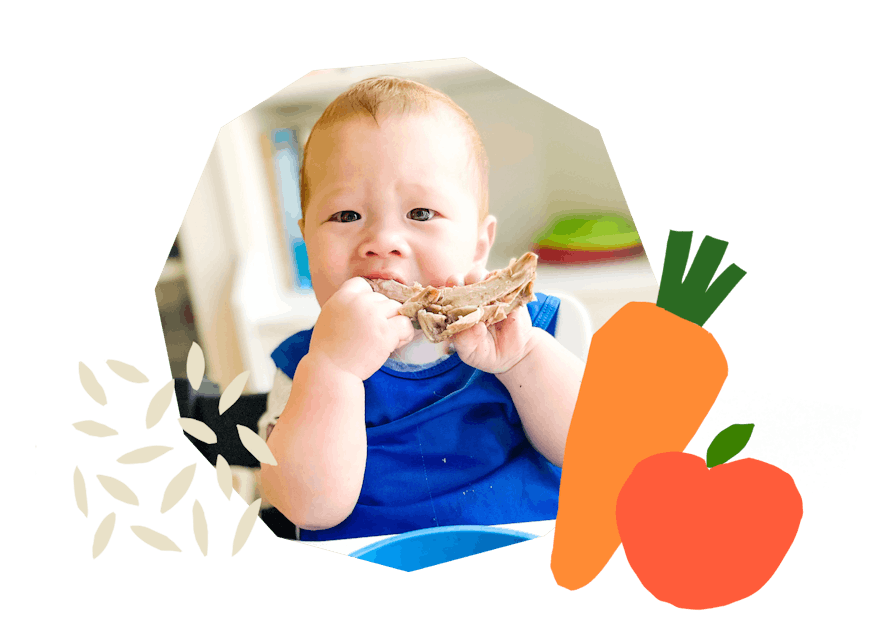
The Program Baby-Led Weaning with Katie Ferraro
A step-by-step digital program for starting solid foods safely and navigating the original 100 FIRST FOODS™ meal plan with baby-led weaning.
 EXPERT-LED, PROVEN APPROACH TO EATING REAL FOOD
EXPERT-LED, PROVEN APPROACH TO EATING REAL FOOD CONCISE VIDEO TRAININGS TO MASTER BABY-LED WEANING
CONCISE VIDEO TRAININGS TO MASTER BABY-LED WEANING 100 FIRST FOODS DAILY MEAL PLAN WITH FOOD PREP VIDEOS
100 FIRST FOODS DAILY MEAL PLAN WITH FOOD PREP VIDEOS
Baby-Led Weaning for Beginners Free Workshop
Is your baby ready to start solid foods, but you’re not sure where to start? Get ready to give your baby a solid foundation to a lifetime of loving real food…even if you’re feeling overwhelmed or confused about this next stage of infant feeding.
Get baby-led weaning recipes and tips delivered to your email inbox.

